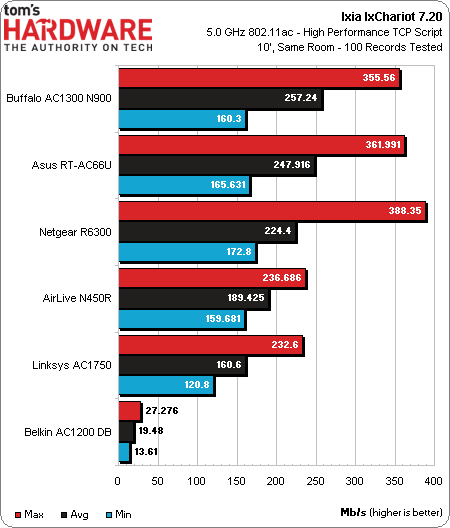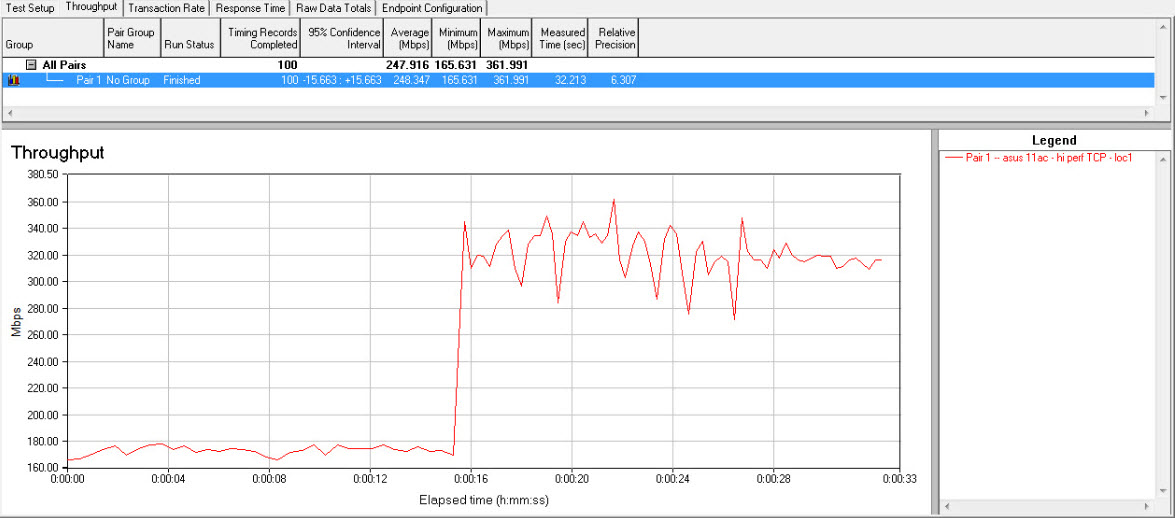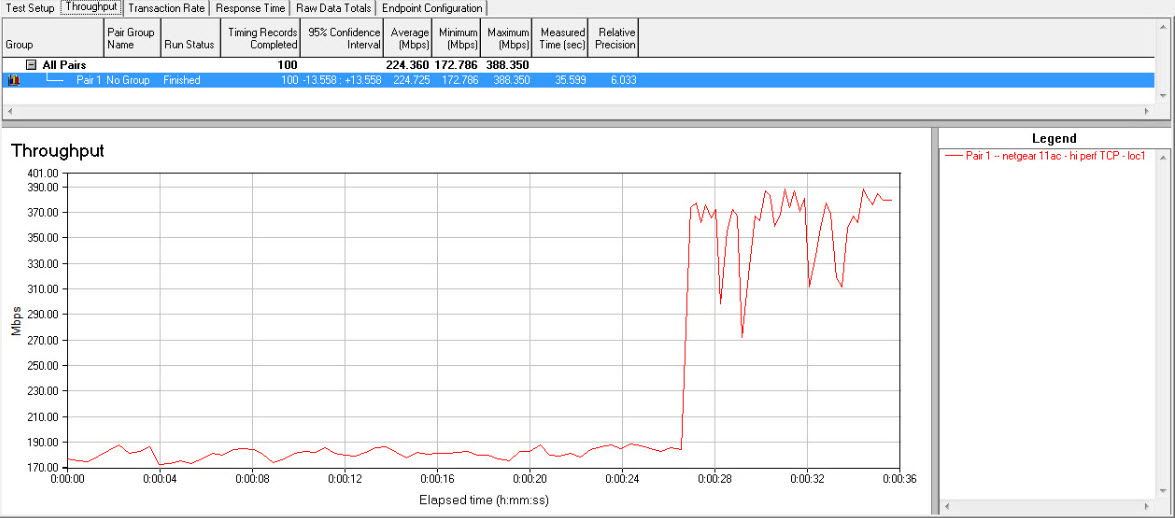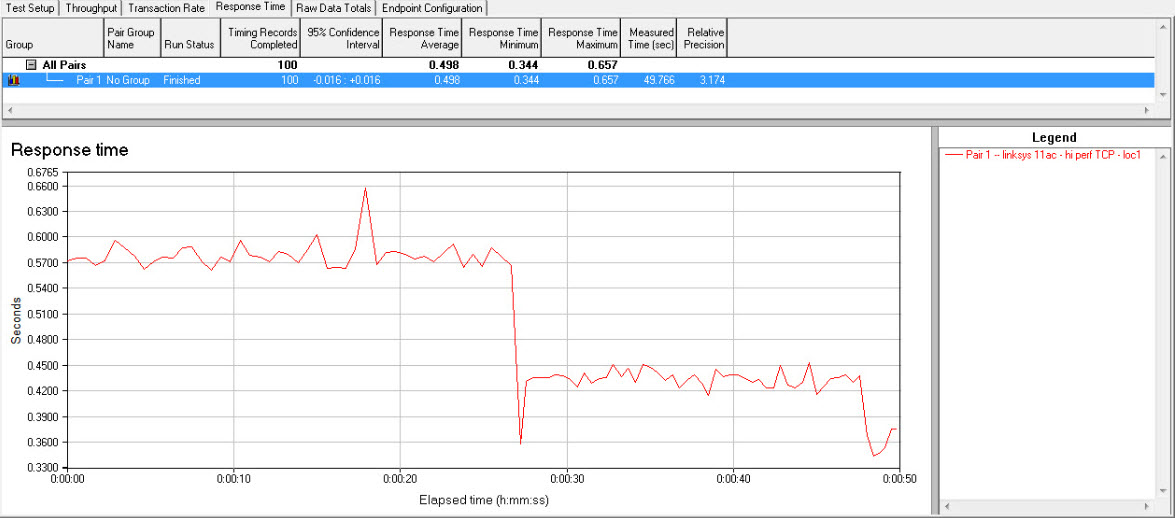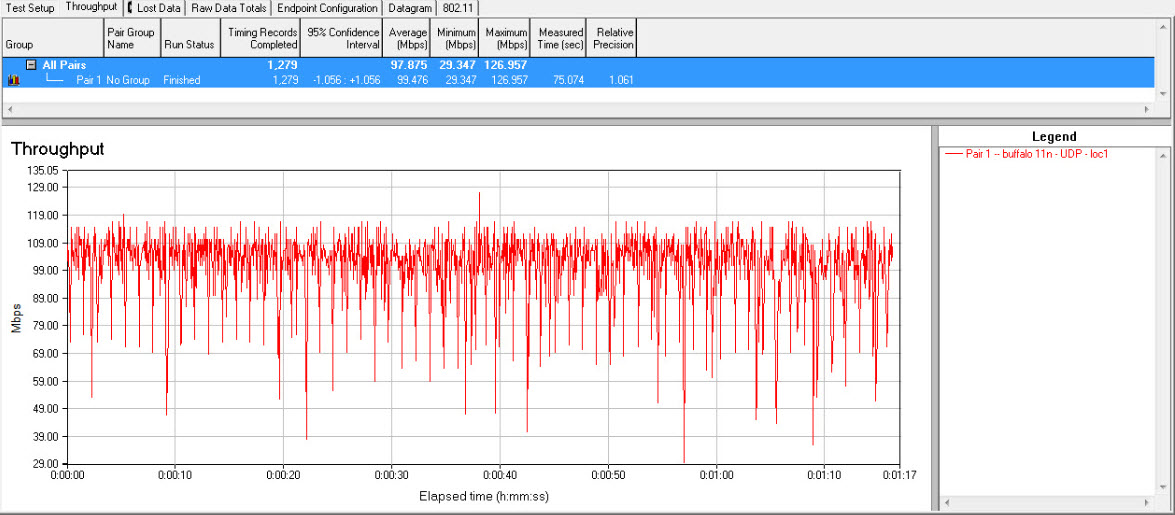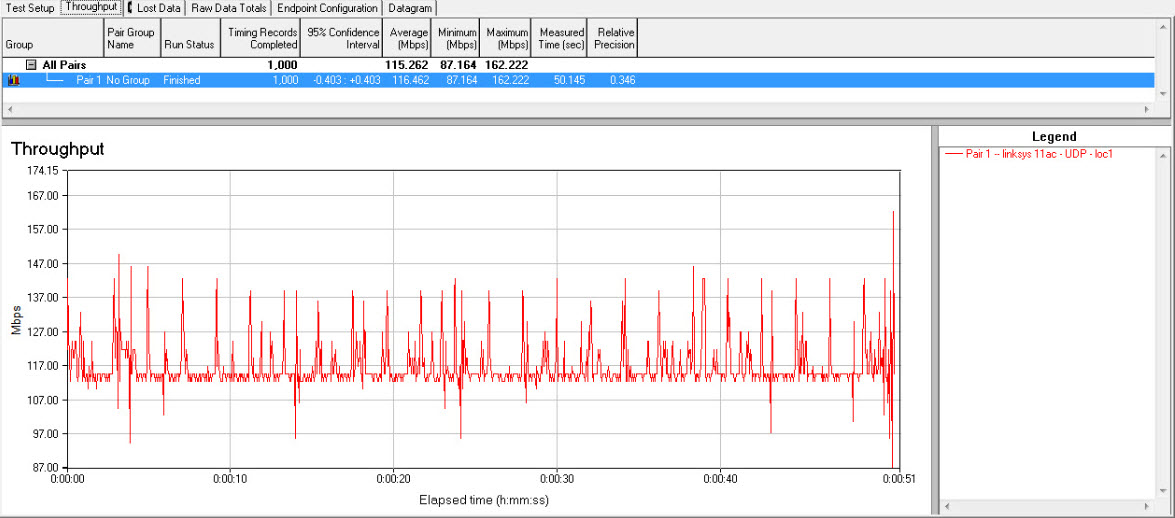Gigabit Wireless? Five 802.11ac Routers, Benchmarked
Five years ago, we didn't have homes with a dozen wireless nodes and the need to run HD video to multiple screens. Today we do. Our 802.11n networks, especially on the 2.4 GHz band, are swamped. Can 802.11ac save the day? We test six routers to find out.
Results: IxChariot, Same-Room, 5.0 GHz
Why you can trust Tom's Hardware
Last up, we have Ixia’s IxChariot, which is probably the most widely used and trusted benchmark in wireless networking.
In our same-room 802.11ac testing for TCP traffic, Belkin sells the only router that falls flat. Even the next-lowest performer, Linksys, averages 160 Mb/s, which is stunning for TCP. Note that AirLive continues to impress at 189 Mb/s, solely on the basis of its beamforming. Just imagine when 11ac vendors cycle through their first wave of routers and decide to implement optional beamforming in their second-gen follow-ups in 2013 or 2014! Now, remember to approach those huge top-end numbers for Asus, Buffalo, and Netgear with caution. For example, here’s what was going on under the hood in Asus' IxChariot throughput graph:
See the plateau shift again? For sure, if we could count on Asus to average 320 Mb/s consistently, we’d bow down and worship this router. However, until we get a better fix on why these shifts keep happening, we’ll keep our adoration in check.
For Netgear, the situation is very similar. While its plateau averages are slightly higher than Asus', and its peak-to-trough range is similar, Netgear’s plateau shift arriving later in the test skews the average throughput downward.
We did not break out response numbers in these analyses since they were essentially inverse mirrors of our throughput charts. Take Linksys’s response graph (above) as an example. One can say that 0.5 second is the average response time, but this clearly depends on when in the test cycle we’re talking about.
If that’s not confusing enough, let’s switch to UDP traffic for the same-room set. Remember how we redlined most UDP results in PerformanceTest 7? IxChariot’s UDP script clearly limits bandwidth—so much so that our UDP numbers underperform our TCP results, which almost never happens.
Yes, our UDP throughput is roughly half of what we saw with TCP. However, regardless of the ways in which IxChariot constricts or relaxes data flow through its scripts, we still have an accurate relative ranking of routers all adhering to the same test process. And within these rules, we see all four of our serious 11ac routers averaging a statistical dead heat.
The plateaus we see in our TCP tests don’t appear here. On the other hand, we see a startling difference in throughput patterns. Consider these two graphs from Buffalo and Linksys. The averages are very close, but the patterns obviously differ.
Which graph is better? We would argue for Linksys. Whereas Buffalo seems to be struggling to keep pressed against a 118 Mb/s ceiling, Linksys has a very defined floor of around 112 Mb/s. When it comes to maintaining quality of service in a stream, the latter pattern is clearly preferable.
Current page: Results: IxChariot, Same-Room, 5.0 GHz
Prev Page Results: PerformanceTest 7 Graphs Next Page Results: IxChariotGet Tom's Hardware's best news and in-depth reviews, straight to your inbox.
-
boulbox Well, i can't wait until i can make my router give wifi all the way to my to my work area.(only a few blocks away)Reply -
I've tested both the R6300 and the RT-AC66U in my home. The R6300 beats it hands down. The average homes won't have the traffic that your artificial software creates. Even your tests show that R6300 in 5ghz mode is faster. People will buy these for gaming and HD movie viewing and the R6300 has better range as well. I've paired my R6300 with an ASUS PCE-AC66 desktop wireless AC adapter and I can acheive 30 MB/S (megabytes) to my HTPC in a 2 story house. That's an insane speed. The RT-AC66U only managed about 15 to 18 MB/s. Also make sure the R6300 has the latest firmware, which is V1.0.2.38_1.0.33. But in conclusion, the R6300 and the RT-AC66U are like a SRT Viper and ZR1 Vette. They are both great pieces of hardware to fit most users needs. Get the ASUS If you got a ton of traffic and a lot of 2.4 ghz devices. Grab the R6300 if you are looking for a friendly setup, max speed, and max range.Reply
-
fwupow Man it sure sucks when you type a long comment and it gets vaporized cuz you weren't logged in.Reply -
DeusAres I'd be happy with a 2Mb/s connection. It'd be better than this horrible 512 Kb/s connection I have now. At least then, I may actually be able to watch youtube vids in 360p.Reply -
fwupow Here's the gist of what I typed before it was rudely vaporized.Reply
I have a dual-band router (Netgear N600). I also purchased a couple of dual-band client USB adapters Linksys AE2500 or something to that effect.
So the USB adapter works fine for a desktop, but having that crap sticking out the side of a laptop, netbook or tablet? Busted in 10 minutes. I hooked one up to my netbook and fried it within a couple of weeks because I'm a Netbook in bed guy. You wouldn't think it could get so hot from a USB port but it does.
So the reality is that you have all these devices that can't be upgraded to dual-band and enjoy very little if any benefit from the new-fangled dual-band router.
The other beef I have with routers is that they're terrible with the way they split up bandwidth between multiple devices. Instead of responsively reassigning bandwidth to the device that needs it, the router continues to reserve a major slice for a device that I'm not using.
If you live in an apartment building, it's actually rather rude to use the full 300Mbps capacity of the wireless N band, since you may well succeed in effectively shutting your neighbor down. There's so much happening in the 2.4GHz band nowadays, it's unreal. Your own cordless keyboards/mice/controllers etc can malfunction from being unable to get a packet in edgewise.
For these dual-band routers to be really useful, we need manufacturers of smartphones, tablets, laptops, netbook and such to build dual-band clients into them because adding the functionality with some sort of dongle just doesn't work. -
memadmax I was a 802.11g and n "adoption" tester....Reply
Never again...
I'll give ac a year or two before I jump on it... -
SteelCity1981 my wireless N produces 300 Megabits which would equal around 37 Megabytes. My highspeed internet doesn't come cloe to reaching 37 megabytes and i don't transfer tons of files wirelesly and my wi-fi rangs is pretty good .So i'm perfectly fine with my 300MB N wireless router right now. Besides that none of my devices spport ac anyhow so it would get bottlenecked from reaching its full potential.Reply -
chuckchurch iknowhowtofixit"Folks, the time to start your 802.11ac adoption is now."I think this review proved that it is time to wait for 2nd generation wireless AC routers to appear before rushing to purchase.Reply
Exactly. The 'client' adapter they used if anyone didn't catch it was a Cisco/Linksys router-sized device. Not practical by any means. It'd be totally insane to make any product recommendations prior to real client adapters being available, or more accurately, embedded ones are available. I think a wireless salesman wrote this article.
